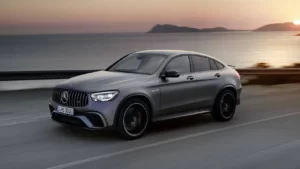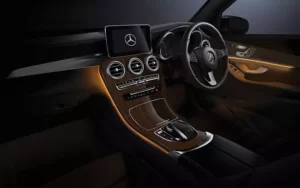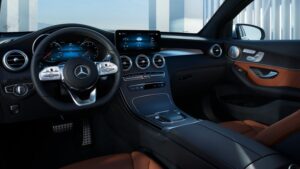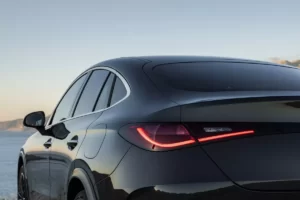The Mercedes GLC Coupe is classic example of the SUV coupe breed. It’s based on the standard GLC, but it has a cosmetically enhanced rear end to appeal to buyers with more sporting aspirations. But it also has a much higher price tag and it’s no different to drive than the conventional car. So, is it worth it or should you just buy one of the best SUVs already on the market?
Coupe SUVs are a bit of a sticking point in the CAR magazine office. Most are no good at being coupes because they’re heavy, tall and cumbersome, and they’re generally less useful than a conventionally shaped SUV because they sacrifice swathes of boot space and rear headroom to their steeply raked rooflines. In almost every case, a more conventional model will serve you better overall.

The Mercedes GLC has another problem. Rivals such as the BMW X4 and Audi Q5 Sportback are cheaper and much better to drive. And if you spent the same amount of money as you would on the range-topping Mercedes GLC Coupe AMG Line Premium Plus, you could have the genuinely sporty (but still compromised) Porsche Cayenne Coupe.
It can’t be that bad, can it?
It isn’t a dreadful car, but its existence is rather pointless. We’ll start with its practicality. The standard GLC has a 620-litre boot, which is larger than all its key rivals. But the coupe surgery has reduced boot space to 545 litres and swallowed a healthy serving of vertical space, which makes it harder to transport tall items. You won’t be able to use it to shop for lofty house plants or large TVs, for example, unless you’re prepared to hack bits off them to transport them home.
In fairness, the GLC Coupe’s boot is only five litres smaller than that of a petrol-powered BMW X3, which is impressive given how much space the coupe rear end throws away. But the X3’s strengths lie in other areas – namely its driving experience and interior quality – so it wasn’t such a sacrifice when BMW turned it into the coupe-ified X4. The standard GLC trades on its practicality, though, which makes the coupe less appealing.


You can’t see out of the back, either. The rear window is very small and very steeply raked, which makes the rear-view mirror completely redundant. You can lose articulated lorries in the blind spots around the GLC Coupe’s C-pillars, which led us to ignore the rear screen entirely and simply check the traffic behind using the door mirrors, as you would when driving a van.
Space in the back isn’t terrible, though. Legroom is almost identical to the standard car and you only lose an inch of headroom in the rear, which means there’s still enough space for six-footers to fit without craning their necks under the roof.
The rest of the interior is exactly the same as the standard GLC’s, so we won’t go into too much detail about it here. You can read more about the car’s interior functionality in our dedicated Mercedes GLC SUV review. One thing we will mention, though, is that the infotainment screen became incandescently hot under the scorching power of a 30-degree Austrian summer.
The screen is mounted high up on the dashboard – and there’s a lot of empty space between the rear of the unit and the trim. That allows the windscreen to concentrate the sun’s rays onto its backside and cook the infotainment screen like a skillet on a bonfire. Simply swapping between menus was enough to sear your fingerprints off, and the extreme heat slowed the touchscreen’s load times down to a crawl. If this global warming lark gets any worse, this minor problem will become a seasonal irritation.
Surely it’s sportier to drive, though?
Nope. It’s exactly the same as the standard GLC, which is to say heavy and rather disengaging. It certainly can’t live up to the sporty ambitions touted by its brochure, especially in the UK. That’s because British buyers won’t be able to specify their cars with the adaptive dampers or rear-wheel steering – and the latter upgrade makes a big difference to the car’s agility.
So far, we’ve only driven the GLC Coupe in Austria. But on that country’s winding Alpine roads, the rear-wheel steering improved the car’s willingness to nose into a corner. At low speeds, the rear wheels turn in the opposite direction to the fronts, which effectively shortens the car’s wheelbase and trims understeer – even if the technology can’t completely eradicate it. The system is clever enough to makes you forget how large the car is on narrow roads, at least until a similarly obnoxious SUV comes the other way and forces you into the verge.
We didn’t think much of the adaptive dampers. The difference in chassis stiffness between Comfort and Sport mode is barely perceptible, which means there isn’t an appreciable reduction in body roll when cornering hard. We also found the suspension to be a little too firm, even in its softest setting. The enormous 20-inch alloys fitted to our test car didn’t help matters, either.
It’s a shame the steering system is so clinical, too. Mercedes has done a great job of isolating the steering wheel from the road surface, which is great if you’re looking for a relaxing cruiser. But it’s frustrating if you’re the sort of keen driver the company is targeting. The lack of feedback meant we often found ourselves second-guessing the amount of lock required for corners.
Which engines can you have?
Fewer than hoped. For some reason, Mercedes decided to not offer UK buyers any of the three plug-in hybrid powertrains available to GLC Coupe buyers on the continent. That’s seems like an enormous oversight considering the tax breaks available to PHEV cars in Britain. A GLC Coupe, bought as a company car with an attractively low Benefit-in-Kind rating and the promise of rock-bottom running costs is perhaps the only way the car makes practical sense.
The only engines available in the UK are the 220d, 300d and 300 petrol. They’re all turbocharged 2.0-litre four-cylinder units and they all feature mild hybrid assistance. Every unit sends drive to all four wheels via a nine-speed automatic gearbox. More on that later, though. We’ll rattle through some performance specifications first.
The entry-level 220d diesel has an output of 194bhp and 325lb/ft of torque, which Mercedes says is enough for a 0–62mph time of 8.1 seconds and a top speed of 140mph. The 300d has a much more impressive 265bhp and 405lb/ft of torque, which slashes the Coupe’s 0–62mph time down to 6.4 seconds and increases its top speed to 155mph.


In lieu of the plug-in hybrid powertrains, we reckon the 300d is the engine to go for. The GLC Coupe is a big, heavy car, but the most potent diesel gives it an impressive turn of speed – and if you’re a little gentler with your throttle inputs, it’ll return upwards of 40mpg in real-world driving. It even sounds quite sporty when worked hard, although it’s a little rattly at low speeds.
The 300 petrol is a little disappointing. It produces 254bhp and 295lb/ft of torque – and Mercedes claims that it’ll dispatch the 0–62mph sprint 0.1 seconds faster than the 300d. But you don’t get that impression from behind the wheel. The engine feels encumbered and needs to be worked incredibly hard to extract the best performance from it. Your ears will hate your right foot for its exuberance, though, because the engine note is very coarse. Ironically, it sounds more like a diesel than the 300d.
Mercedes’s automatic gearbox isn’t the most refined unit, either. It’s clunky and jerky at low speeds, and a little dim-witted once you’re on the open the road. For example, when you overtake on the motorway from a cruise, it takes the gearbox a solid two seconds to find the correct gear once the throttle contacts the firewall.
There isn’t a manual override mode, either. You can temporarily select your own gears using the paddles behind the wheel, but if you don’t manually change gear for a while (say, when using engine braking to control your speed when descending a hill) it’ll switch back to auto mode.
Verdict
We’d recommend you avoid the Mercedes GLC Coupe. It simply isn’t worth the extra money over the conventional SUV. It doesn’t drive any better than the standard car, which means it’s of little interest to petrolheads – and the practicality sacrifices it makes dampen its appeal for family buyers.
Mercedes’s decision to hand the UK market an incomplete line-up hasn’t helped matters, either. We can’t specify our cars with adaptive dampers, rear-wheel steering or any of the car’s three plug-in hybrid powertrains. That means, on average, British GLC Coupes are less dynamic and more expensive to run than they are on the continent.
If you want a mid-sized Mercedes SUV, just stick with the standard GLC SUV. But if you’re hell-bent on owning a mid-sized coupe SUV, you’d be better served by the BMW X4 or Audi Q5 Sportback. They are better coupes, even if they abandon some of their SUV-ish-ness to achieve that.

Source: Carmagazine




